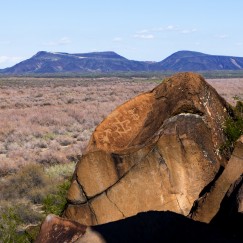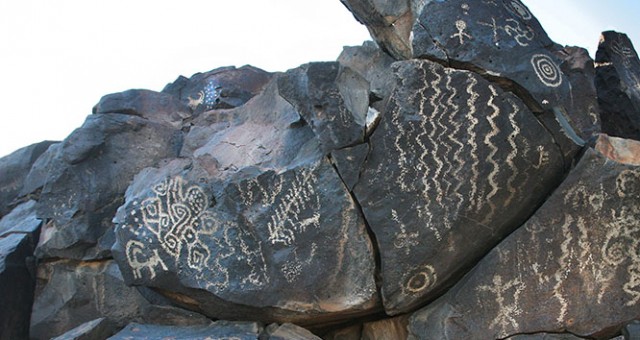- Home
- >
- Press Releases/Announcements
- >
- National Monument Would Bring Economic Benefit to ...

Archaeology Southwest and the National Trust for Historic Preservation continue to work with local communities and stakeholders to seek their input and support for a legislative designation for the Great Bend of the Gila.
[From the Gila Bend Chamber of Commerce and the National Trust for Historic Preservation]
For Immediate Release
August 14, 2014
Media Contacts:
Christina Hubbard, Coordinator, Gila Bend Chamber of Commerce, 928.420.1964: chris.gbcc@hotmail.com
Tim Mikulski, National Trust for Historic Preservation, 202.588.6083: tmikulski@savingplaces.org
Gila Bend, Ariz. (August 14, 2014) — According to a new economic study released today, protecting the nationally significant cultural and historic resources along the Great Bend of the Gila River would contribute an estimated $1.3 million annually to Arizona’s Maricopa and Yuma Counties through increased tourism.
The study by BBC Research & Consulting indicated that a public land designation, such as a national monument, will increase visitation to the Great Bend of the Gila area and provide a significant economic boost to this rural area.
“Increased attention from a national monument designation will bring more in-state, out-of-state and international visitors to the Great Bend of the Gila as well as the Sonoran Desert National Monument,” said Steve Holt, Mayor of Gila Bend. “The many historic trails of the Sonoran Desert National Monument make it a premier recreation destination, which is what we hope to see for the proposed Great Bend of the Gila National Monument as well.”
U.S. Representative Raúl Grijalva (D-Ariz.) introduced the Great Bend of the Gila National Monument Establishment Act (H.R. 1348) in March, 2013. The proposed national monument runs 75 miles along the Gila River with main gateway communities of Gila Bend and Yuma. It includes the archaeological remains of ancestral Hohokam and Patayan cultures, as well as three historic trails—the Juan Bautista de Anza, the Butterfield Stagecoach and the Mormon Battalion—marking the struggles of those men and women who braved the Western frontier.
“Permanent protection as a national monument would help to ensure that the irreplaceable historic, sacred and natural resources of this landscape are available for future generations to enjoy and appreciate,” said Chris Hubbard, coordinator for the Gila Bend Chamber of Commerce.
In addition to protecting significant sacred and archaeological sites, a national monument designation would allow for a wide range of uses including horseback riding, backpacking, biking, motorized vehicle use and scientific research. Current livestock grazing and hunting would also continue in the proposed national monument. The designation would also protect an important military fly-over zone in the area.
“This area represents an important crossroads of culture throughout history to the present time,” said Rebecca Knuffke, program manager of public lands policy for the National Trust for Historic Preservation. “This designation will permanently protect lands and resources sacred to many Arizona tribes for future generations, while also bringing long term economic benefits to both Maricopa and Yuma counties through an increase in cultural and heritage tourism.”
Researchers looked at Sonoran Desert National Monument, a neighboring national monument similar to Great Bend of the Gila, and determined that if also made a national monument, the Great Bend of the Gila area would be likely to experience similar tourism growth due to increased heritage and recreation visitors.
If designated, the Great Bend of the Gila National Monument would join the Bureau of Land Management’s National Conservation Lands where cultural and historic resources typically receive more funding than those outside of the system.

Background on the Great Bend of the Gila
With Archaeology Southwest as a Local Partner, the National Trust for Historic Preservation is involved in preserving the Great Bend of the Gila, one of the Bureau of Land Management’s most important cultural landscapes in the Southwest. It includes the archaeological remains of ancient Hohokam and Patayan cultures; world-class rock art at places such as Quail Point (a portion of which is now owned and protected by Archaeology Southwest); three nationally significant historic trails, the Juan Bautista de Anza, Butterfield Stagecoach, and Mormon Battalion; remnants of historic homesteading, mining and ranching; and the site of the westernmost skirmish of the Civil War.
About the Economic Study
The study, “Economic Impacts of National Monument Designation: Great Bend of the Gila” by BBC Research and Consulting of Denver was commissioned to assess the economic impact of designating Great Bend of the Gila a national monument. In its 40-year history, BBC has completed thousands of similar impact analyses for public, private and non-profit clients. The study can be found at http://www.preservationnation.org/assets/pdfs/saving-places/GBG-Economic-Impacts-Final-Report-8-8-2014.pdf.
About the National Trust for Historic Preservation
The National Trust for Historic Preservation, a privately funded nonprofit organization, works to save America’s historic places. PreservationNation.org.
###
Explore the News
-
Join Today
Keep up with the latest discoveries in southwestern archaeology. Join today, and receive Archaeology Southwest Magazine, among other member benefits.